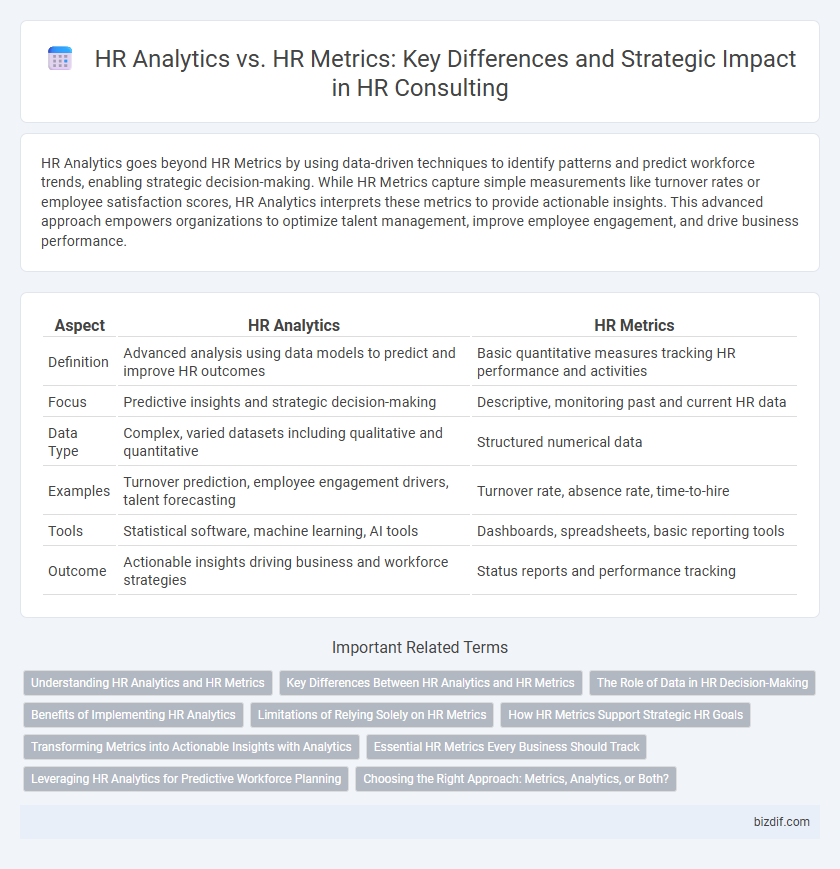HR Analytics goes beyond HR Metrics by using data-driven techniques to identify patterns and predict workforce trends, enabling strategic decision-making. While HR Metrics capture simple measurements like turnover rates or employee satisfaction scores, HR Analytics interprets these metrics to provide actionable insights. This advanced approach empowers organizations to optimize talent management, improve employee engagement, and drive business performance.
Table of Comparison
| Aspect | HR Analytics | HR Metrics |
|---|---|---|
| Definition | Advanced analysis using data models to predict and improve HR outcomes | Basic quantitative measures tracking HR performance and activities |
| Focus | Predictive insights and strategic decision-making | Descriptive, monitoring past and current HR data |
| Data Type | Complex, varied datasets including qualitative and quantitative | Structured numerical data |
| Examples | Turnover prediction, employee engagement drivers, talent forecasting | Turnover rate, absence rate, time-to-hire |
| Tools | Statistical software, machine learning, AI tools | Dashboards, spreadsheets, basic reporting tools |
| Outcome | Actionable insights driving business and workforce strategies | Status reports and performance tracking |
Understanding HR Analytics and HR Metrics
HR Analytics involves the use of advanced data analysis techniques and predictive modeling to uncover patterns and insights about employee behaviors, performance, and organizational trends. HR Metrics refer to specific quantitative measures such as turnover rates, time-to-hire, and employee satisfaction scores that track HR processes and outcomes. Understanding the distinction allows organizations to move beyond basic reporting, leveraging HR Analytics for strategic decision-making and improved workforce management.
Key Differences Between HR Analytics and HR Metrics
HR Analytics involves in-depth data analysis and predictive modeling to uncover patterns and forecast workforce trends, while HR Metrics primarily track and report basic quantitative data such as turnover rates and absenteeism. HR Analytics provides actionable insights to support strategic decision-making by evaluating employee performance, engagement, and talent acquisition effectiveness, whereas HR Metrics focus on measuring operational efficiency and compliance. The key difference lies in HR Analytics' forward-looking approach and qualitative assessment compared to the retrospective, quantitative emphasis of HR Metrics.
The Role of Data in HR Decision-Making
HR Analytics delivers predictive insights by interpreting complex workforce data, enabling more strategic decision-making compared to HR Metrics, which primarily track basic employee statistics. The role of data in HR decision-making is pivotal; advanced analytics transforms raw HR metrics into actionable intelligence that forecasts trends, enhances talent management, and optimizes organizational performance. Utilizing data-driven HR Analytics fosters evidence-based strategies, reducing biases and improving outcomes in hiring, retention, and employee engagement.
Benefits of Implementing HR Analytics
Implementing HR Analytics enhances decision-making by transforming raw HR metrics into predictive insights that optimize workforce planning and talent management. This approach identifies patterns in employee performance, turnover, and engagement, enabling proactive interventions that reduce costs and improve productivity. Organizations leveraging HR Analytics gain a competitive advantage through data-driven strategies that align human capital with business objectives.
Limitations of Relying Solely on HR Metrics
HR metrics provide quantitative data such as turnover rates and time-to-fill positions but lack the depth needed to interpret workforce trends and employee behaviors accurately. Relying solely on HR metrics can lead to misleading conclusions because they do not capture the qualitative aspects like employee engagement, culture, or performance drivers. Integrating HR analytics enables a more comprehensive analysis by combining data insights with predictive modeling to inform strategic HR decisions.
How HR Metrics Support Strategic HR Goals
HR metrics provide quantifiable data on employee performance, turnover rates, and recruitment efficiency that align directly with strategic HR goals. These metrics enable organizations to track progress, identify gaps, and make data-driven decisions to enhance workforce productivity and engagement. By linking HR metrics to business outcomes, companies ensure that HR initiatives contribute effectively to overall organizational success.
Transforming Metrics into Actionable Insights with Analytics
HR Analytics goes beyond traditional HR Metrics by not only measuring workforce data but also interpreting patterns to drive strategic decisions. By leveraging advanced analytical techniques, HR Analytics transforms raw metrics into actionable insights that optimize talent management, enhance employee engagement, and improve organizational performance. This data-driven approach enables HR leaders to anticipate trends, personalize interventions, and align human capital strategies with business goals.
Essential HR Metrics Every Business Should Track
Essential HR metrics every business should track include employee turnover rate, time to hire, employee engagement scores, and absenteeism rate, as these provide critical insights into workforce stability and productivity. HR analytics goes beyond basic metrics by leveraging data analysis and predictive modeling to identify trends, forecast workforce needs, and improve strategic decision-making. Tracking these metrics enables organizations to optimize talent management, reduce costs, and enhance overall employee performance.
Leveraging HR Analytics for Predictive Workforce Planning
Leveraging HR analytics enables predictive workforce planning by analyzing patterns in employee performance, turnover, and engagement to forecast future talent needs. Unlike HR metrics that track historical data, HR analytics applies advanced data modeling and machine learning techniques to anticipate workforce trends and optimize recruitment strategies. Integrating predictive analytics into HR decision-making improves talent retention, aligns workforce capabilities with business goals, and reduces labor costs.
Choosing the Right Approach: Metrics, Analytics, or Both?
Selecting the right approach between HR metrics and HR analytics depends on organizational goals and data maturity. HR metrics provide straightforward, quantitative snapshots such as turnover rates and absenteeism, enabling quick performance tracking. HR analytics offers deeper insights by applying statistical models to uncover patterns and predict outcomes, driving strategic decision-making and workforce optimization.
HR Analytics vs HR Metrics Infographic

 bizdif.com
bizdif.com